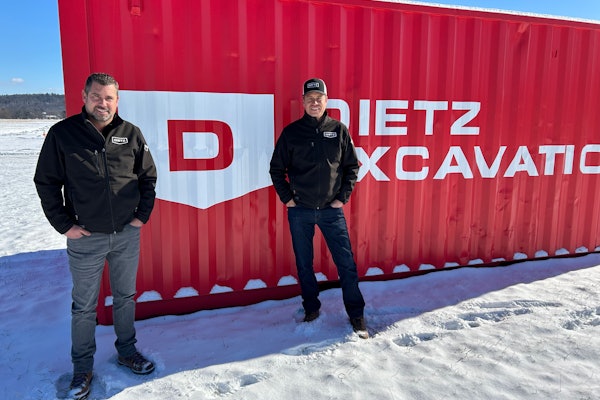The Greening of America’s Highways
Words like sustainability, carbon footprint and environmental stewardship have dominated the construction industry for the past half-decade, driving some highway engineers to protest the buzz and beg their information sources to go back to covering advances in materials and technology that make roads better.
More and more, those topics are intertwined: advances that make pavements perform better or cost less – or both – usually also bring advances in sustainability.
The other remarkable aspect of pavement sustainability is the pace of change. In the past few years, under the press of economics, science and marketing forces, the science of sustainable concrete and asphalt pavements has evolved quickly, with advances in everything from production and technology to communicating best practices.
To keep pace with the changes, Better Roads reviewed recent developments with representatives from the National Asphalt Pavement Association (NAPA) and the American Concrete Pavement Association (ACPA).
In terms of conventional methods of measuring carbon footprints, concrete pavement’s great strength is its inherent longevity. Its greatest vulnerability is the amount of carbon dioxide released in the production of Portland cement.
“The cement industry has taken dramatic steps to reduce any environmental impact of the manufacturing process, reducing the amount of energy to make a ton of product by more than 33 percent since 1972,” notes Leif Wathne, PE, ACPA vice president of highways and federal affairs. He adds that the Cement Manufacturing Sustainability Program is pledged to reduce CO2 emissions by another 10 percent per ton from 1990 levels by 2020.
In addition, he notes, research is underway at MIT’s Concrete Sustainability Hub to achieve future carbon reductions through nanotechnology. “Science is looking for a better understanding of Portland cement — at the molecular level,” says Wathne. “There are some pretty exciting prospects on that front.”
Meanwhile, the concrete paving industry is focusing on pragmatic solutions to the challenges of the day — sustainability and cost reduction.
“One obvious tactic is reducing the amount of Portland cement in the mix,” says Wathne. “We’ve been substituting industrial waste products like fly ash and steel slag for decades. A lot of our work now is aimed at stimulating wider adoption of these products by communicating to agencies what kind of substitutions are possible for various applications.”
When fly ash or slag resources are located near a project, the substitution of either product can substantially reduce concrete’s carbon footprint and its cost while enhancing or preserving its pavement qualities.
Like the asphalt industry, concrete interests work to convince agencies with prescriptive specifications for mix content to think more in terms of performance specifications. Wathne notes, for example, that the average DOT probably allows fly ash concentrations of 20 to 25 percent of the cementitious material, while others allow less, and others, like Delaware and Florida, use concentrations of 50 to 70 percent.
Wathne’s group is also trying to reduce costs and enhance sustainability by encouraging mix optimization and reduced pavement thickness.
Reductions in pavement thickness are expected to come from widespread adoption of AASHTO’s newest edition of the Mechanical Empirical Pavement Design Guide (MEPDG).
Mix optimization focuses on creating a combination of materials that allows the engineer to minimize the amount of cement in the mix. “The biggest factor here is aggregate gradation,” notes Wathne. “The goal is to find sizes and shapes that pack together in an optimal way, so you can use less ‘paste’ and thereby save on cost and carbon.”
Reductions in pavement thickness are expected to come from widespread adoption of AASHTO’s newest edition of the Mechanical Empirical Pavement Design Guide (MEPDG), the software version of which is known as DARWin-ME. The concrete paving industry, like the asphalt industry, hails the potential this pavement design discipline has for eliminating “over-designed” pavements and the waste they represent in unneeded materials, energy and cost.
Of course, cautions Wathne, some of those overdesigned pavements performed extraordinarily well when estimates of traffic loads turned out to be dramatically low, so improved practices in forecasting traffic loads is an essential part of the goal of efficient design.
Getting Warm
In the asphalt paving industry, the past two years has brought a flurry of advances in recycling practices and mix design. The elephant in the room – the development pavement engineers must understand – is the warm mix phenomenon.
Imported from Europe a decade ago on a trial basis, NAPA saw warm mix as a way to reduce fumes and enhance the working environment for paving crews. The product was demonstrated at the 2004 World of Asphalt and trialed around the country over the next several years, during which time a variety of other benefits were discovered, most notably: easier compaction, less sensitivity to ambient temperatures and haul distances, and an excellent medium for high-ratio RAP (reclaimed asphalt pavement) blending.
Not to mention: a reduction in carbon footprint of 10 percent or more based on energy savings alone. Using the greenhouse gas calculator on NAPA’s website (www.asphaltpavement.org), Howard Marks, Ph.D, JD, MPH, director of environmental and regulatory affairs for NAPA, demonstrated a conservative example of the savings.
“If a plant produces mix at 250 F rather than 300 F, the calculator shows a 10-percent fuel savings” says Marks. A 10-percent fuel savings will reduce CO2 emissions by 10 percent, from 45.5 pounds per ton mix to 41 pounds. But we’ve seen up to 15-percent fuel savings documented during field trials.”
The use of warm mix has mushroomed. “In 2009, warm mix production hit 17 million tons in the U.S., and in 2010 it went to 47 million tons,” notes Margaret Cervarich, NAPA’s vice president of marketing.
Usage is being driven by the mix’s construction virtues. “In states where contractors can use hot or warm mix, many contractors are opting for warm mix because it yields a nicer work environment and it’s easier to compact,” notes Kent Hansen, PE, NAPA’s director of engineering. “Even if there’s a slight increase in the cost of warm mix, they make it up in eliminating penalties or getting bonuses for density.”
Asphalt’s already low carbon footprint will decline even more as the warm mix marketshare grows, and it is expected to continue its rapid growth curve for the foreseeable future. NAPA forecasts that warm mix will claim 50 percent of the asphalt market in three to five years.
Pragmatic Solutions
Like the concrete paving industry, asphalt’s emissions-reducing progress is also being fueled by a need to reduce pavement costs.
For asphalt, the leading edge on this front centers on integrating ever-higher concentrations of reclaimed asphalt pavement (RAP) into mixes and on the use of reclaimed asphalt shingles (RAS) to counter the impact of higher costs for virgin asphalt cement.
Growing sophistication in engineering RAP mixes – and increased confidence in them among DOT pavement professionals – has brought a steady increase in RAP ratios. NAPA’s Kent Hansen says RAP currently comprises about 18 percent of asphalt placed in the United States, up from an estimated 12 percent in 2007.
The upward trend seems certain to continue as pioneering states are allowing 35- to 50-percent RAP mixes for base and intermediate courses, and up to 25 percent for surface courses. Some states have no limit — contractors just have to meet design standards set by the state.
The industry has also aggressively adopted recycled shingles in mix designs to supplant a portion of the virgin asphalt cement and thus reduce costs.
Asphalt advocates, like those for concrete, are working to reduce pavement thickness as a way to reduce costs and carbon footprints. In addition to supporting the adoption of AASHTO’s DARWin-ME, the industry has used Auburn University’s National Center for Asphalt Technology to establish new structural values for modern mix designs. The new values substantially reduce the thickness required for various load projects.
Porous/Pervious Pavements
Perhaps no pavement development has won more friends in the environmental community than the advent of porous asphalt and pervious concrete.
Designed to allow stormwater to drain directly through the paved surface and percolate into the subbase, these pavements are winning favor in environmentally-sensitive areas and in developments where space for water retention is at a premium.
Where the technologies of the two industries clash, the conflict is almost always about cost-effectiveness and service life, and sustainability usually benefits from the competition.
They have become an important option for parking lot design, but road agencies are finding creative applications for them, too, from the City of Chicago’s “Green Alley” — a program which employs pervious concrete or porous asphalt for alleys to mitigate storm water run-off — to California’s experimentation with porous asphalt for road shoulders to enhance water quality.
No matter what pavement material is used, a significant factor in the sustainability of any pavement depends on the ability of pavement engineers to stay current with – and open-minded about – advances in materials, technologies and techniques that lower costs and enhance the environment.
Advocates for asphalt and concrete alike focus much of their efforts on communicating best practices to DOT and consulting engineers.
Often times, the best-practices message regards technology that has been proven in one place, but not adopted in many others.
For Leif Wathne and ACPA, one example of this is educating the road industry on today’s best practices for partial-depth repairs of concrete joints. While construction delays caused by concrete or asphalt pavement maintenance are a relatively small portion of the pavement sustainability picture, reducing repair times improves service to the motorist and usually reduces costs – and reduces carbon emissions from traffic slowdowns.
“This isn’t magic pixie dust,” Wathne says of ACPA’s Partial Depth Repair of Concrete Pavements. “This is proven process and methodology from states that have developed real expertise in this area, incorporating newer technologies like precision mills to get the job done more efficiently.”
Similarly, NAPA’s Hansen and Marks labor to educate engineers on the design and application of high-RAP/RAS mixes.
Some of the most interesting areas of education are where concrete and asphalt come into direct conflict. This includes ACPA’s campaign for unbonded overlays as an alternative to asphalt overlays. It also includes NAPA’s campaign for Perpetual Pavement, a full-depth asphalt pavement designed for long service life.
Where the technologies of the two industries clash, the conflict is almost always about cost-effectiveness and service life, and sustainability usually benefits from the competition.
Looking Forward
While most future advances in pavement sustainability will likely come from incremental improvements in materials, methods and technology – and the communication of those advances to pavement engineers throughout the country – there is the potential for revolutionary advances down the line.
In concrete circles, the MIT research to apply nanotechnology to reduce carbon dioxide emissions in the production of Portland cement is certainly a case in point.
On the asphalt side, publicly- and privately-funded research is exploring the potential for organic products derived from materials like vegetation waste or algae to replace asphalt cement.












